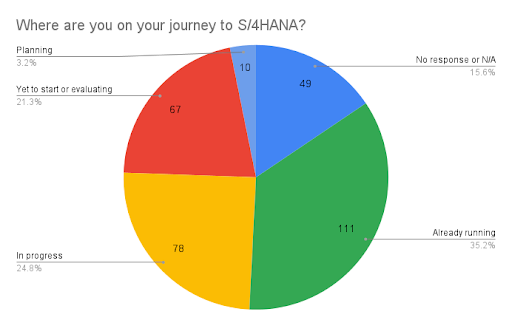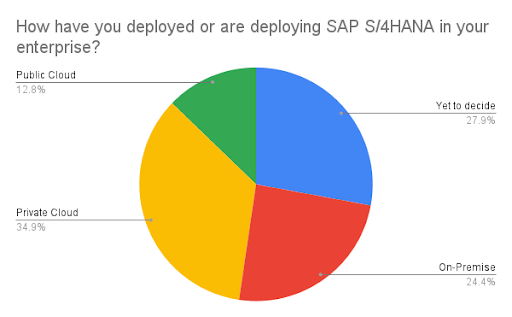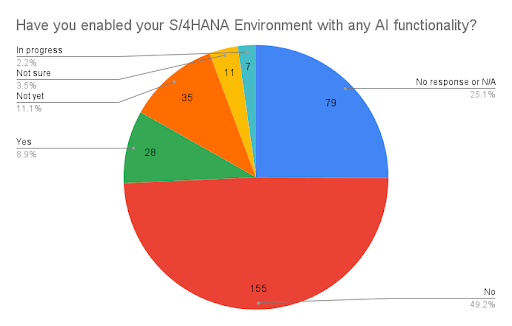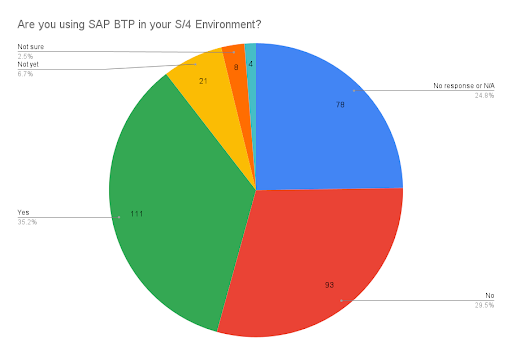We’ve been speaking with several enterprise leaders—both those already on SAP S/4HANA and those still considering the move—in the context of AI’s rapidly evolving landscape. A prominent observation remains constant: there is a strong sense of being overwhelmed with the internal pressure for leaders to drive efficiency gains and innovation, all while navigating external factors such as shifting economic and socio-political conditions, and of course, AI, whose promises seem to multiply by the minute.
This context motivated us to host a roundtable, creating a space to exchange insights on how SAP customers can maximize their S/4HANA investment and harness its AI capabilities. The topic struck a chord within the SAP community, drawing 315 registrants eager to learn from our special guest, Dr. Jared Coyle, Chief AI Officer for SAP America. In this blog, we’ll share some insights on where customers are in their digital transformation journey, what’s top of mind, what are the top AI features in S/4HANA, forward looking trends, and concrete actions to take in order to boost organizational productivity.
Survey Insights: Where SAP Customers Stand on S/4HANA, AI, and SAP Business Technology Platform
Ahead of and during our roundtable discussion, we conducted a survey to gauge where SAP customers are on their S/4HANA journey, AI adoption, and SAP BTP usage. The responses paint a clear picture of the varying stages of digital transformation and highlight the challenges and opportunities organizations face.
1. S/4HANA Adoption: A Spectrum of Maturity
SAP customers are at different stages in their journey toward S/4HANA. Roughly one-third (35.2%) have fully migrated to S/4HANA, while nearly half (45.7%) are either currently implementing or in the early planning stages, highlighting a substantial need for best practices and guidance for value realization.

2. Deployment Models: On-Prem, Cloud, or Hybrid?
When it comes to how companies are deploying S/4HANA, the distribution is varied. Deployment preferences lean toward Private Cloud (34.9%) and On-Premise (24.4%), though 27.9% remain undecided, emphasizing critical decision-making around control, security and customization needs.

Jared highlighted a complex challenge with migrating to S/4HANA, which was adherence with SAP Clean Core principles that necessitates a human-centered approach:
“The Clean Core issue isn’t purely technical—it’s fundamentally about human governance. Organizations naturally have unique processes tied to competitive advantages. However, the primary obstacle in maintaining a clean core often arises from human and governance factors”
3. AI Adoption in S/4HANA: The Early Days
AI enablement within S/4HANA environments is still in its infancy, with fewer than 1 in 10 organizations actively leveraging AI capabilities in their S/4HANA environment. However, with over 11% planning to adopt AI, interest is growing, and organizations may be looking for the right use cases and implementation strategies.

4. SAP BTP Usage: A Divided Landscape
SAP Business Technology Platform (BTP) adoption presents a mixed picture. There is active adoption among 35.2% of respondents; however, over 38% have either not adopted or are still evaluating it, pointing to possible awareness gaps or implementation challenges.

Overall, these survey results reflect the diverse pace of S/4HANA adoption, AI implementation, and SAP BTP enablement across organizations. While some have fully transitioned, many are still exploring and evaluating their next steps. As AI and cloud capabilities become increasingly central to realizing business value, the challenge for SAP customers is not just moving to S/4HANA, but ensuring they maximize the efficiency, intelligence, and agility that these technologies offer.
What’s Top of Mind for SAP Customers?
Participants at our roundtable expressed strong interest in several key areas critical to successful AI adoption:
- AI Knowledge, Learning, and Strategy: Understanding the latest advancements, ethical considerations, and ROI calculations for AI.
- Migration and Integration: Navigating the transition from ECC to S/4HANA and leveraging SAP Business Technology Platform (BTP) for improved integration and AI capabilities.
- Developer Enablement: Enhancing developer productivity, quality assurance, and security through AI-driven tools.
- Process Automation and Improvement: Utilizing AI for automation, workflow optimization, and better decision-making.
- Industry-Specific AI Use Cases: Participants highlighted a strong interest in leveraging AI to address industry-specific challenges in sectors such as finance, procurement, supply chain, retail, utilities, healthcare, and manufacturing.
- Line-of-Business (LoB) Innovations: Enhancing various LoB processes such as Finance (Accounts Payable, Receivables Management), Procurement (guided buying and spend insights), and Operations (predictive maintenance, asset management).
In addressing these thoughts, Jared shared some insightful responses below.
SAP’s Strategic Approach to AI Adoption
What was worth noting is that AI in SAP is not monolithic; it falls into different categories:
- Embedded AI: Pre-trained capabilities directly within S/4HANA — it’s “just there.”
- Bolt-On AI: Add-on functionality via SAP BTP through integration or extension.
- Build / Custom AI: Built from scratch for complex & tailored solutions (while keeping the core clean), using tools like SAP AI Foundation, or other tools like Google, Databricks, or Microsoft, that integrate with SAP.
The graphic below illustrates the different categories or use case patterns Jared shared at the previous SAP BTP Summit.

We also discussed at length the various ways to overcome those top of mind challenges:
- Human-in-the-loop: SAP intentionally keeps human oversight to manage risk and maintain quality.
- Authorization and Data Privacy: AI capabilities follow existing SAP authorization frameworks.
- Regulatory and Compliance: AI applications are designed to comply with EU AI Act and other regulations.
- AI vs. RPA: Agentic AI offers greater learning and decision-making capabilities compared to traditional RPA.
Next, we dove into the key AI capabilities and use cases of SAP S/4HANA customers.
What are the top AI features that SAP S/4HANA customers can use today?
Basing off of SAP’s release highlights and SAP Business AI Features, together with Jared we discussed key AI features in our roundtable that are actively driving transformation and addressing specific LoB and industry challenges:
- Expense Management: Automated Receipts Scanning and auditing processes for expense reporting—the number one use case born out of necessity.
- Finance and Accounting: Intelligent Invoice Processing, Predictive Analytics & Anomaly Detection, Margin & Profitability Analysis, SAP Cash App for streamlined receivables.
- Procurement and Spend Management: AI-Powered Procurement with guided buying and advanced spend analytics.
- Sales and Customer Service: Sales Order Automation and enhanced customer engagement through AI-driven customer service.
- Supply Chain and Operations: Predictive Maintenance & Asset Management, Material Requirements Planning (MRP), Delivery Status Predictions, and Warehouse AI Vision.
- Manufacturing and Quality Assurance: Quality Management supported by advanced Computer Vision technology.
- Technology and Development: SAP Joule for conversational AI interfaces and Code Generation capabilities (RAP & CAP), accelerating developer productivity.
- Cross-Industry Extensions: Custom Generative AI Solutions and integration with third-party AI tools like OpenAI and Process Mining.
All in all, what stood out was the shared observation that AI is especially helpful in handling “boring” work—those mundane tasks like submitting expenses or manually entering invoice data, which not only consume valuable time in an employee’s daily routine but also create unnecessary friction in their day-to-day work experience.
The rewards of Human-Centered AI
Reducing the pain of doing repetitive (and boring) transactional tasks opens up space and time for employees, enabling them to shift their focus toward more meaningful work, as Jared puts it:
“Our job as technologists familiar with AI is to provide users the ability to leverage what is uniquely human—the mind’s creativity and its ability to generate new concepts. Technology should surround and support this creativity, allowing users to engage naturally.”
Jared also emphasized the necessity of a human-centric design, not only to facilitate adoption but also to manage compliance risks:
“SAP intentionally incorporates ‘humans in the loop’ for nearly all AI scenarios, driven primarily by risk management and emerging regulatory frameworks like the EU AI Act. Over time, we anticipate global regulatory standards requiring human oversight.”
He further elaborates with SAP Cash Application as an example:
“Take SAP Cash App: certain manual document matchings no longer require human involvement. AI integration won’t be binary but rather a gradient, balancing automation with human oversight based on risk.”
Ultimately, the successful integration of new technology like AI requires a human-centered approach coupled with strong governance and organizational change management strategies to ensure meaningful SAP enterprise transformations.
Forward-Looking AI Trends in SAP S/4HANA
Having gone through the top AI features with customer stories, we also discussed several emerging AI trends that will shape future SAP environments:
- Partner Ecosystem & Third-Party AI Integration: SAP is actively fostering an ecosystem with 60+ partners developing more than 80 AI use cases. This ecosystem helps organizations leverage external AI capabilities seamlessly within SAP.
- Clean Core with Side-by-Side AI: SAP is reinforcing a clean core strategy, recommending the management of complex AI processes (like deep learning or NLP) through side-by-side services on SAP BTP rather than direct S/4 customizations.
- Generative AI and Autonomous AI Agents: The next significant advancement involves AI agents capable of autonomously managing entire business tasks, freeing humans to handle strategic oversight and exceptions, fundamentally reshaping the ERP user experience.
- Industry-Specific AI Innovations: Customized scenarios addressing specific sector requirements, such as demand forecasting in retail, outage predictions in utilities, or inventory management in healthcare.
- Embedded AI Use Cases: Increasingly, SAP delivers out-of-the-box AI solutions, enriching standard SAP S/4HANA capabilities with each new release, minimizing the need for extensive custom development.
Getting Started and Accelerating Your AI Journey
Organizations at different stages have distinct needs and opportunities. To strategically accelerate your AI journey:
- Organizations migrating or new to S/4HANA (including ECC clients): Begin integrating AI early, leveraging migration as an opportunity to implement immediate high-value AI solutions. Early AI adoption ensures quicker value realization and smoother transitions.
- Organizations exploring AI opportunities (across deployment models): Develop roadmaps that clearly identify and prioritize high-impact AI use cases. This targeted approach maximizes ROI and aligns AI strategies with broader business goals.
- S/4HANA Cloud and On-Premise clients ready for AI activation: Guidance and targeted support help swiftly activate embedded AI features and custom AI solutions, ensuring rapid prototyping and timely realization of tangible benefits, demonstrating immediate and measurable business value.
Also, here are some further readings that would supplement your AI journey with SAP S/4HANA:
- For leaders and decision makers – insights from Paru Sankar, Mindset’s Managing Director for India’s subsidiary, on S/4HANA AI evolution and why it is now a strategic imperative
- For enterprise architects – a handbook by Robb Neuenschwander, our Principal Architect, on leveraging capabilities of SAP BTP to gain strategic advantage, and by Ethan, our Dev Ops lead and SAP Mentor on using Joule with S/4HANA on-premise
- For developers – insights on Joule and ABAP by Jelena Perfiljeva, Mindset’s Expert SAP Developer
Final Thoughts
AI adoption in SAP S/4HANA is fundamentally about augmenting human potential, enabling users to shift from transactional tasks to strategic activities and creative problem-solving. Organizations proactively embracing AI will position themselves effectively for sustained competitive advantage.
Ready to realize AI’s potential for your business? Let’s discuss your AI strategy to suit your SAP landscape—particularly around roadmapping high-value use cases with Embedded and/or tailored AI capabilities in S/4HANA— and how to ensure adoption with business impact.